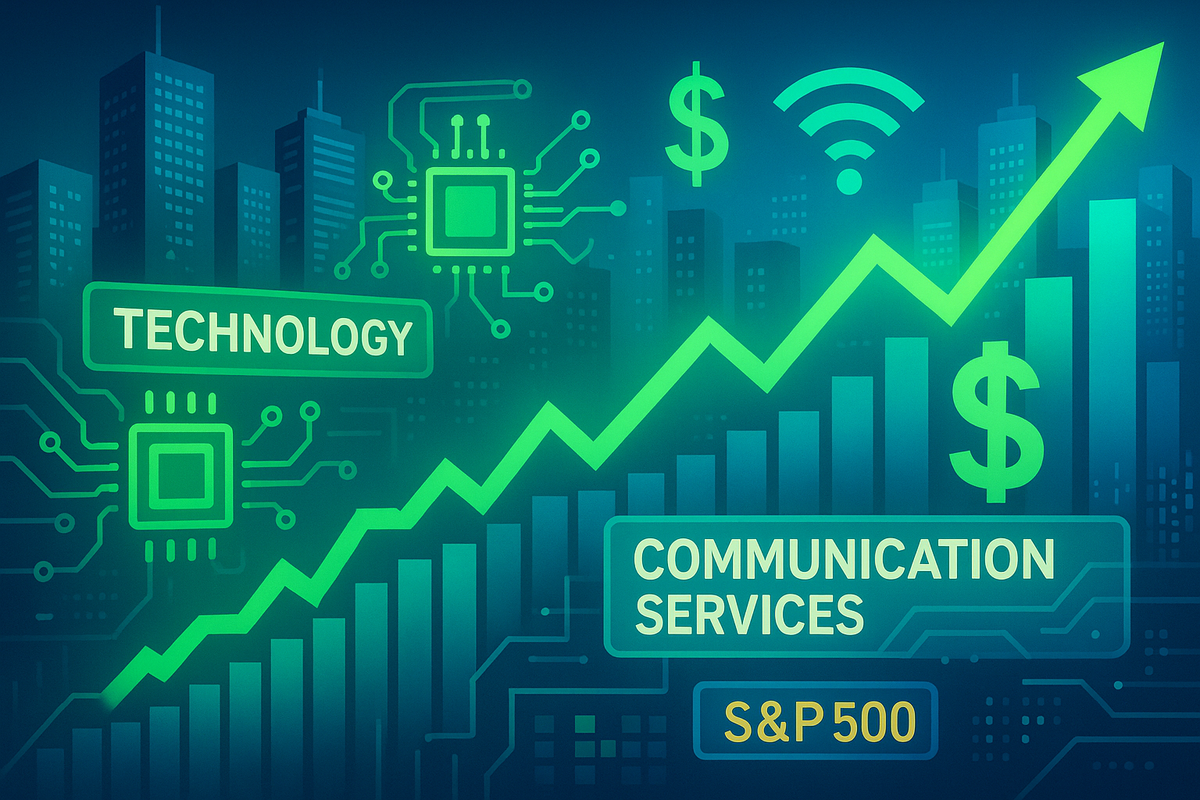
The S&P 500 has recently experienced a robust upswing, with the Technology and Communication Services sectors leading the charge, demonstrating significant gains of 1.6% and 1.9% respectively. This impressive performance, coupled with positive movements in Financials, Consumer Discretionary, Industrials, and Materials, signals a broad-based market rally and renewed investor confidence. The immediate implications point to a "risk-on" environment, fueled by optimistic inflation data and the strong likelihood of impending interest rate cuts by the Federal Reserve.
This widespread market strength suggests that investors are increasingly confident in the economic outlook, anticipating a period of sustained growth driven by more accommodative monetary policies and robust corporate performance. The current market dynamics indicate a shift towards growth-oriented sectors, while also showing resilience across cyclical industries, painting a picture of a healthy and expanding economy.
What Happened and Why It Matters
On Tuesday, August 12, 2025, the S&P 500 witnessed a remarkable day, with all 11 broad sectors closing in positive territory, and the index itself advancing 1.1% to a new closing high. The standout performers were the Technology Select Sector SPDR (XLK) and the Communication Services Select Sector SPDR (XLC), which saw gains of 1.6% and 1.9% respectively. These sectors have been consistent drivers of market rallies, with their growth often linked to innovation and evolving consumer behaviors, particularly in the realm of artificial intelligence (AI).
The timeline of events leading to this moment is crucial. The primary catalyst was the release of the Consumer Price Index (CPI) report for July, which revealed that annual inflation held steady at 2.7%, slightly better than economists' expectations of 2.8%. This cooler-than-expected inflation reading significantly bolstered investor optimism regarding a potential 25 basis-point interest rate cut by the Federal Reserve at its next policy committee meeting in September. This expectation of lower borrowing costs is a powerful stimulant for economic growth, making it cheaper for businesses to invest and for consumers to spend.
Key players involved in this market movement include the Federal Reserve, whose monetary policy decisions heavily influence market sentiment, and the corporations within the S&P 500, whose strong Q2 earnings have provided a fundamental underpinning for the rally. Approximately 81% of S&P 500 companies reported actual earnings per share (EPS) above estimates, with a blended growth rate tracking over 11% year-over-year. Initial market reactions have been overwhelmingly positive, with the S&P 500 and Nasdaq Composite reaching new record highs, reflecting a broad-based "risk-on" rally. This sentiment is further supported by easing trade tensions, which have also contributed to pushing stocks to record levels.
Winners and Losers in the Current Market Surge
The recent S&P 500 surge has created clear winners, particularly within the Technology and Communication Services sectors, while also highlighting areas that may experience less direct benefit or face increased competitive pressures. The broad market strength, however, suggests a generally favorable environment for many companies.
In the Technology sector, mega-cap giants are the primary beneficiaries. Companies like NVIDIA (NASDAQ: NVDA), Microsoft (NASDAQ: MSFT), Apple (NASDAQ: AAPL), Amazon (NASDAQ: AMZN), Alphabet (NASDAQ: GOOGL), and Broadcom (NASDAQ: AVGO) are seeing substantial gains. Their significant investments in artificial intelligence (AI) and cloud infrastructure are fueling increased revenue and higher valuations. NVIDIA, for instance, is benefiting immensely from its proprietary CUDA platform, which enhances datacenter efficiency for AI applications. Semiconductor companies like NVIDIA and Advanced Micro Devices (NASDAQ: AMD) are experiencing robust investor confidence due to the high demand for chips essential for AI and other technological advancements. Cloud service providers such as Amazon's AWS and Microsoft's Azure are expanding their capital expenditures to convert datacenters into accelerated computing hubs, directly benefiting from the generative AI boom. Software and data analytics firms leveraging disruptive technologies like AI, such as Palantir (NYSE: PLTR) and Oracle (NYSE: ORCL), are also expected to continue driving market returns. These companies are experiencing increased demand, leading to higher sales, earnings, and market capitalization, which in turn attracts further investment for research and development. Conversely, smaller tech players that fail to rapidly adapt to new technological advancements or diversify their supply chains may face intensified competitive pressure from these dominant players.
The Communication Services sector's gains are largely propelled by AI adoption, robust digital advertising revenue, and the ongoing expansion of interactive media and services. Meta Platforms (NASDAQ: META) and Alphabet (NASDAQ: GOOGL) are key drivers, benefiting from investor enthusiasm over AI and improving fundamentals, including cost-cutting efforts and strong consumer spending driving digital advertising revenue. AI helps these companies enhance existing businesses, such as personalized digital advertising, and explore new revenue streams. Wireless and broadband service providers, more defensive constituents within the sector, such as AT&T Inc. (NYSE: T), are benefiting from the continued rollout of 5G technology, which increases demand for equipment and services. Entertainment and gaming companies like Electronic Arts (NASDAQ: EA) and Live Nation (NYSE: LYV) have also reached new highs, indicating strength in the broader entertainment and media sub-industries. These companies are seeing increased online engagement and advertising activity, leading to higher revenues and earnings. However, traditional media outlets and some streaming services might face challenges from market saturation and new competition, potentially limiting their pricing power.
Beyond these leading sectors, the positive performance in Financials, Consumer Discretionary, Industrials, and Materials signals broad market strength, as these sectors are often cyclical and thrive during economic expansions. In Financials, diversified banks like JPMorgan Chase (NYSE: JPM), payment processing firms such as Visa (NYSE: V) and Global Payments (NYSE: GPN), and investment banks like Goldman Sachs (NYSE: GS) are benefiting from steady economic growth and a rebound in corporate debt, equity issuances, and M&A activity. Consumer Discretionary companies, including Tesla (NASDAQ: TSLA), The Home Depot (NYSE: HD), and Nike (NYSE: NKE), are seeing increased sales due to strong consumer confidence and disposable income. Industrials, such as GE Vernova (NYSE: GEV) and United Airlines (NASDAQ: UAL), are benefiting from increased government spending on infrastructure and nearshoring trends. Finally, Materials companies like Nucor (NYSE: NUE) and Sherwin-Williams (NYSE: SHW) are experiencing increased demand for raw materials driven by strong economic activity and infrastructure development. While these sectors are broadly benefiting, companies less exposed to the specific drivers of growth within their respective industries might see comparatively slower gains.
Industry Impact and Broader Implications
The robust sectoral performance within the S&P 500, particularly the significant gains in Technology and Communication Services, alongside positive movements in Financials, Consumer Discretionary, Industrials, and Materials, signals a complex yet broadly resilient market environment. This widespread strength suggests that corporate America has largely managed to absorb inflationary pressures and higher interest rates better than anticipated, alleviating some concerns about an impending recession. The current S&P 500 earnings season, with companies across various sectors reporting significant year-over-year profit and revenue growth, indicates surprising corporate health and resilience, providing an optimistic backdrop for future economic forecasts and potentially underpinning market stability.
This event fits into broader industry trends primarily through the pervasive influence of Artificial Intelligence (AI). AI is not just a driver for the Technology and Communication Services sectors but is increasingly impacting manufacturing, industrial applications, and broader business infrastructure, as evidenced by the outperformance of the Industrials sector. Mega-cap technology companies are not only major drivers but also significant beneficiaries of this AI surge, attracting substantial investment and talent due to their perceived resilience and capacity for consistent growth. AI is driving increased personalization of digital advertising, improving efficiency for companies reliant on digital ad revenue, which significantly benefits Communication Services heavyweights like Meta Platforms (NASDAQ: META) and Alphabet (NASDAQ: GOOGL). The Financials sector has also outperformed, partly due to lower price-to-earnings ratios and the potential for increased lending activity from anticipated interest rate cuts, with potential deregulation further supporting this sector.
The strong performance of leading companies, particularly the "Magnificent Seven" in Technology and Communication Services, creates significant ripple effects on competitors and partners. Companies directly competing with these dominant players face an increasingly challenging environment, struggling to match their scale, resources, and innovation. This pressure can accelerate investment in technology and talent for competitors to keep pace. Conversely, partners and suppliers to these dominant tech firms may experience increased demand for their services and products, though their fortunes become closely tied to the success of a concentrated few, potentially leading to further industry consolidation. The high valuations in the U.S. market can also act as a magnet, drawing capital away from international markets, impacting growth prospects in other regions. Furthermore, companies are under immense pressure to not just meet, but significantly exceed, profit growth expectations to justify their current stock prices, with even strong earnings reports sometimes leading to stock price drops if revenue falls short or if expectations are already elevated. This environment is seeing a widening gap between large, globally connected companies with pricing power and diversified supply chains, and smaller, consumer-facing companies that are more exposed to the business cycle and seeing profits stall.
The concentrated nature of the S&P 500's gains raises several regulatory and policy implications. Sustained corporate profitability, especially among dominant players, might draw increased scrutiny regarding pricing strategies and market concentration. The heavy concentration of market capitalization in a few mega-cap technology companies introduces systemic risk; if these dominant players falter due to regulatory scrutiny, trade policy shifts, or a cooling of AI hype, the entire index could face a sharp correction. The perceived overvaluation of the U.S. stock market also presents a delicate dilemma for the Federal Reserve, as decades of artificially low interest rates may have fueled the current market bubble by encouraging excessive risk-taking. Historically, the current level of market concentration in a few dominant tech stocks surpasses even the peak of the dot-com bubble, highlighting an unprecedented reliance on a narrow set of companies for overall index performance. However, unlike some past periods of "irrational exuberance," the current rally is largely fueled by real earnings strength and corporate resilience, with companies demonstrating an ability to expand margins despite challenges like higher tariffs. The pervasive influence of AI across multiple sectors is a relatively new and powerful driver, distinguishing the current period from previous cycles.
What Comes Next
The S&P 500's recent surge, propelled by robust sectoral performance in Technology and Communication Services, alongside positive movements in Financials, Consumer Discretionary, Industrials, and Materials, sets the stage for a dynamic period ahead. Both short-term and long-term possibilities suggest continued growth, albeit with potential shifts in market leadership and underlying dynamics.
In the short term, the S&P 500 is generally assessed as technically positive, showing strong development within a rising trend channel. Projections from institutions like Goldman Sachs anticipate further gains, with the S&P 500 Index potentially rising 6% to 6,600 in the next six months and 11% to 6,900 in the next 12 months. These optimistic forecasts are largely driven by expectations of earlier and deeper interest rate cuts from the Federal Reserve and the continued strength of the largest stocks. The impressive earnings per share (EPS) growth for the S&P 500, currently tracking over 11% year-over-year for Q2 2025, further supports this positive outlook. However, this optimism is tempered by concerns about market breadth. While the S&P 500 has reached record highs, the median stock within the index is more than 10% below its 52-week high, indicating narrow market breadth. This concentration of gains in a few mega-cap technology stocks, often referred to as the "Magnificent Seven," raises concerns about the sustainability of the rally if these leaders falter. The next few months could see either a "catch down" by recent market leaders or a "catch up" by recent laggards.
Looking further out, the long-term outlook remains generally positive, though potentially with more muted gains compared to recent exceptional returns. Capital Economics has revised up its end-2025 forecast for the S&P 500 to 6,750 and projects it to finish 2026 at 7,250, citing the US economy's resilience and growing enthusiasm for AI. A key long-term driver is the continued adoption of artificial intelligence, which could lead to a productivity boom and enhance margins and profitability across various industries. However, long-term returns for the S&P 500 are more likely to be in the 3%-6% range over the coming decade, as valuation and margin expansion, which drove exceptional returns in the past decade, are unlikely to continue at the same pace.
Given these dynamics, several strategic pivots or adaptations may be required for investors. The concept of sector rotation, where investors reallocate to the strongest-performing sectors, is highlighted as an effective strategy to potentially outperform traditional buy-and-hold approaches. With market breadth concerns, investors might need to diversify beyond the heavily concentrated mega-cap tech stocks, as opportunities may emerge in under-owned sectors like Industrials, Healthcare, and Financials if the rally broadens. A continued focus on companies that can deliver consistent earnings growth, regardless of their current valuation, will also be crucial. Market opportunities include the ongoing AI-driven growth, potential boosts from interest rate cuts, and the possibility of a broadening rally. However, challenges such as tariff policy uncertainty, the risk of an "AI bubble burst" if heavy capital expenditure on AI infrastructure doesn't translate into future profitability, and persistent inflationary pressures could impact market performance. While a "super bullish" scenario with continued uptrends and new all-time highs is possible, investors should also consider scenarios ranging from a "mildly bullish" continuation with slower growth to a "mildly bearish" corrective move, or even an "ugly" scenario involving a significant market collapse if the AI bubble bursts or trade wars escalate.
Conclusion
The recent robust sectoral performance within the S&P 500, particularly the significant gains in Technology and Communication Services, alongside positive movements in Financials, Consumer Discretionary, Industrials, and Materials, paints a picture of broad market strength and renewed investor confidence. This widespread positive momentum is underpinned by a confluence of factors, including cooler-than-expected inflation data, robust corporate earnings, and growing optimism for impending interest rate cuts by the Federal Reserve.
Key takeaways from this event include the pivotal role of softer inflation reports in boosting market sentiment and fueling expectations of monetary policy easing. The second-quarter earnings season has been a significant catalyst, with S&P 500 earnings per share (EPS) growth tracking over 11% year-over-year, largely driven by the communications and technology sectors. Investor enthusiasm surrounding artificial intelligence (AI) continues to provide substantial support and drive strong performance within the technology sector, while easing tariff concerns and an improving economic outlook have also contributed to the positive market environment.
Moving forward, the market appears poised for continued upward momentum, with analysts suggesting there is still room for further gains. The prevailing sentiment is that the Federal Reserve will begin its monetary policy easing cycle soon, with a high likelihood of rate cuts in the coming months. While earnings growth is forecast to moderate, it is still expected to remain positive for the remainder of 2025. Despite some signs of economic slowing, a recession is not widely anticipated, and growth is projected to reaccelerate in 2026, supported by factors like fiscal stimulus and potential deregulation.
The significance and lasting impact of these sectoral gains lie in their reflection of a market supported by both strong corporate fundamentals and a more accommodative monetary policy outlook. The positive earnings revisions, a rare occurrence, serve as a quiet yet powerful catalyst underpinning the market's advance. The sustained dominance of mega-cap technology stocks continues to exert a substantial influence on the overall index. For the bull market to be truly sustainable, broadening participation beyond these few giants will be essential. The current environment suggests a resilient market capable of navigating economic shifts, with strong earnings providing a solid foundation.
Investors should closely monitor several key indicators and developments in the coming months. These include upcoming economic data, particularly future inflation reports, labor market data, and the Producer Price Index (PPI) report, as these will heavily influence the Federal Reserve's decisions and commentary. Continued vigilance on corporate profitability and forward guidance is necessary, especially as the broader and lasting impact of recently implemented or proposed tariffs might become more evident. Finally, observing whether the market rally continues to broaden beyond the dominant technology and communication services sectors will be crucial for assessing the long-term sustainability of the current market strength.

















